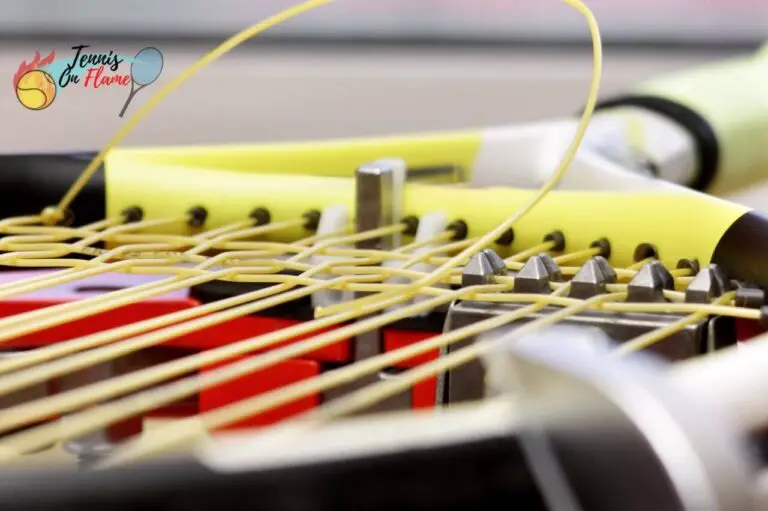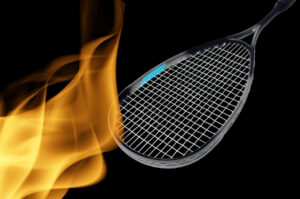There are a variety of different tennis racket strings on the market these days which makes tennis players wonder how often pros restring their tennis rackets.
If you’re a tennis player, then you know that keeping your racket in good condition is essential to your success on the court.
One way to do this is by regularly restringing your racket. But how often should you do this?
In this guide, we will discuss how often pros restring their rackets and offer some tips on how you can lengthen the life of your racket.
Let’s start!
Do tennis strings have a shelf life? (and How often should you restring your racket?)
Yes, tennis string does expire after a certain period. There is no definitive answer to the question of exactly how long they last though.
This is because some tennis strings can last for several months while others might only be good for one month. It all depends on the type of string you choose and how often you play with it.
As a general rule of thumb, you should replace your tennis strings in a year as often as you play in a week. So, if you’re playing twice a week, restring your racket twice a year.
This will help to ensure that you’re always playing with fresh strings that are optimized for your game.

So how often do pros restring a tennis racket?
Pros typically restring their rackets every day or two. This ensures that they always have fresh strings and that their racket is in top condition.
If you’re not a pro, you probably don’t need to restring your racket quite so often. But if you want to make sure your racket is always performing its best, consider restringing it more often.
This will help to lengthen the life of your racket and ensure that you’re always playing with optimal strings.
What are the benefits of restringing your racket?
There are several different benefits associated with restringing your tennis racket, including:
1. Better vibration dampening: Over time, your strings will lose their elasticity and won’t be able to absorb the vibrations as well.
This can lead to more arm pain and discomfort. By restringing your tennis racket you will absorb the vibrations, and you can help to prevent or alleviate the pain of the tennis elbow.
2. Increased power: With fresh strings, you’ll get more spin on the ball and more power behind your shots. This can help you take your game to the next level.
3. Greater comfort: Worn-out strings can cause your racket to feel less comfortable. By restringing it, you’ll be able to enjoy your game more and won’t have to worry about any discomfort.
5. shot delivery: With frayed or old strings, your shots won’t be as consistent. But with new strings, you can have greater control over where the ball goes.
you’ll get a better sense of the ball. This can help you improve your accuracy and make more precise shots.
In general, restringing your racket will provide numerous benefits that can help improve your game. It’s important to do it regularly, especially if you play often.
How do I know if my tennis strings are dead?
There are a few key signs that your tennis strings are dead:
1. Your strings are unraveling quickly.
2. After points, your strings are moving considerably more twisted than usual.
3. You hear a “thud” when your strings make contact.
4. You notice as if you have less control over the ball than usual.
If you notice any of these signs, it’s time to restring your racket. Doing so will help you enjoy your game and play at your best.
How do you make tennis strings last longer?
There’s no way to make tennis strings last indefinitely, but there are things you can do to maintain them for as long as possible.
Here are a few tips:
1. Play with fresh strings: The fresher your strings, the longer they’ll last. So don’t wait too long to restring your racket.
2. Us a thicker gauge size.
3. Another idea is to change the string material to a thicker one. (from 18g to 17g or 16g).
4. Us synthetic gut or polyester string.
5. Don’t over-tighten your strings: This can cause them to break prematurely. Find a tension that’s comfortable for you and stick with it.
6. Be careful with your racket: Avoid dropping or hitting your racket on hard surfaces. This can damage the strings and shorten their lifespan.
7. Don’t leave your racket in direct sunlight for long periods.
8. Store your racket in a cool, dry place when not in use.
Following these tips can help you extend the life of your strings and ensure that you always have fresh, optimally performing strings.
What is a Natural Gut string?
First, The natural gut string was made from the sheep gut, but today natural gut string is made from the cow gut.
This string has been used for centuries and is still considered one of the best-performing strings in existence. It offers excellent power, feels, and control, and it’s also very durable.
They also tend to last longer than other types of strings ( between 120 to 150 hours of playing), although they can be more expensive.
What is a synthetic gut string?
A synthetic gut string is made from nylon or other synthetic materials.
They are often considered to be the best type of string for beginners because they are cheaper and easier to maintain than natural gut strings.
Synthetic gut strings tend to last between 10 to 20 hours of play.
They also have a relatively high elasticity, which helps players to generate more power and speed.
What is a co-polyester string in a tennis racket?
Co-polyester tennis strings are made from a blend of two different polymers, which results in a synthetic tennis string that’s versatile and durable.
This type of string is often used by both intermediate and advanced players who want a powerful string with excellent control.
Co-polyester strings also tend to last between 10 to 20 hours of play.
What kind of tennis strings do pros use?
The type of tennis string that a pro uses depends on their playing style, needs, and preferences.
However, the vast majority of pros use polyester strings because they offer a good balance of power, control, and durability.
What type of string lasts longer?
As a general rule, the thicker the gauge (or thickness) of a string, the longer it will last.
That’s because thicker strings (15) are less likely to break under tension. They also have more mass, which means they’re less likely to move around as much and unravel.
However, thicker strings can also be more difficult to control and may not offer as much power as thinner strings.
So it’s important to find a balance that works for you. Ultimately, the best way to extend the life of your strings is to take good care of them and practice proper string maintenance.
How much does it cost to restring the tennis racket?
It typically costs around $40 to have a tennis racket restrung.
However, this price can vary depending on the string type and brand you choose (between $15 to $75).
It may cost more to have a natural gut string restrung, as this is considered to be the best type of string for playing tennis.
On the other hand, it may cost less to have a synthetic gut string restrung because they are cheaper and easier to maintain.
The labor cost for restringing a tennis racket is usually $10-25 per racket.
The cost of the strings themselves is usually $2-50 per set.
Where should you restring your tennis racket?
You should always restring your tennis racket in a place that has been approved for this purpose.
You can either take it to the manufacturer or buy a kit to do it yourself.
Manufacturers will usually be happy to provide you with an address somewhere appropriate.
If you prefer to use a kit, make sure you carefully follow the instructions to avoid any damage to your racket.
If you’re looking for a stringer, check your local club, or sports shops, or look online.
You can click here to purchase strings.
In conclusion:
Tennis strings have a shelf life and will eventually need to be replaced. The frequency of replacement depends on the type of string, playing habits, and string maintenance.
As a general rule, natural gut strings last between 120 to 150 hours of playing, while synthetic gut strings last between 10 to 20 hours. Co-polyester strings also tend to last between 10 to 20 hours of play.
The type of tennis string that a pro uses depends on their playing style, needs, and preferences. However, the vast majority of pros use polyester strings because they offer a good balance of power, control, and durability.
I hope this guide has helped you understand how often you should restring your racket. Remember, the key is to find a balance that works for you!
If you have any questions or comments, please feel free to reach out to me and leave me a comment down below. I would be more than happy to help!
Thanks for reading and take care of your racket! 🙂








